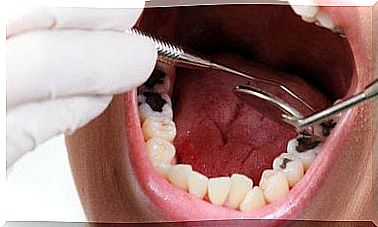Buerger’s Disease: Everything You Need To Know

Buerger’s disease is a rare disease also called thrombangiitis obliterans. This disease causes inflammation in certain blood vessels, such as the arteries and veins of medium and small caliber. That’s why it’s important to learn the potential treatments for Buerger’s disease.
In the vast majority of cases, people who suffer from this disease are smokers. And while we don’t know much about the direct cause, it’s more common in certain geographic areas. For example, we see it more often in the Mediterranean and Southeast Asian countries.
The problem is that Buerger’s disease can have very serious consequences. One is that one of your limbs may need to be amputated. In today’s article, we’ll talk about the causes, symptoms, and treatment of Buerger’s disease.
What is Buerger’s Disease?
Buerger’s disease is a condition that affects the blood vessels. It is also called thrombangiitis obliterans. It causes inflammation in the blood vessels. These then become blocked by blood clots.
According to a study by Actas Dermo-Sifiliográfica (Spanish link), most people with this disease are young men who smoke. It appears to be the result of an autoimmune mechanism activated by tobacco.
Although it is a rare disease, we have seen that it is more common in the Mediterranean or Asian countries. After the blockage in the arteries has occurred, the tissues behind the blockage no longer receive oxygenated blood.
Therefore, this condition damages the tissues and causes necrosis. Most often, this disease most commonly affects the hands and feet. However, as the disease progresses, it can also spread to your arms and legs. When the tissues die, a person is at very high risk of having to undergo amputation.
Symptoms of Buerger’s Disease
The symptoms associated with this disease result from the damage to the blood vessels. Because it damages both medium and small veins and arteries, it is common for a person to notice problems in the limbs first.
Specialists at the Mayo Clinic explained that one of these symptoms is claudication. It causes pain in the feet or legs, which occurs after you have used it for a while. For example, it is common to feel it when you walk. Normally the feeling disappears when you stand still for a while. For example for a shop window.
Then the lack of blood supply will eventually lead to skin damage. After that, ulcers or necrotic spots may appear. In addition to smoking, the problem can also be caused by the cold or stress.
Another typical symptom is Raynaud’s phenomenon. In this condition, your fingers or toes turn pale because certain triggers impede your blood flow. The most superficial veins will suffer from episodes of inflammation. This is called superficial thrombophlebitis.
Tobacco: the main cause

Buerger’s disease, as we have already explained, is associated with tobacco use. Tobacco smoking or chewing may be the cause, but we don’t know the exact cause. It appears to be an immune system response to tobacco itself.
The Spanish Academy of Dermatology and Venerology (Spanish link) has conducted a study explaining how there may be a particular genetic predisposition to this condition. That would explain why only a small percentage of smokers get this disease.
This theory is also supported by the fact that we see a higher prevalence of this disease in certain countries (Asia and Mediterranean countries). Buerger’s disease is more common in people with the HLA-A9 haplotype.
Risk Factors
As you have read, tobacco is the main risk factor. The more you consume, the more likely you are to develop this condition. Gender may also play a role, as it is more common in men than in women.
However, this could be partly due to the fact that until recently men smoked more than women. Most cases are found in young people, under the age of 45.
Diagnosis
According to a study published in Integral Medicine (Spanish link), the diagnosis of Buerger’s disease is clinical. If a young patient begins to experience the aforementioned symptoms and he smokes and has no other risk factors, then he should see a doctor.
It is also important to rule out other autoimmune diseases or the possibility of a stroke. Several tests can help confirm this diagnosis, and the blood test is an easy way. This blood test can help rule out other conditions, such as scleroderma or bleeding disorders.
Angiography is another useful study. This allows you to check the condition of the veins and arteries for possible damage. In addition, the Allen test allows your doctor to observe arterial blood flow in the hand.
Treatment of Buerger’s Disease
Because we don’t know the exact cause of this disease, experts have not been able to determine an ideal treatment for Buerger’s disease either. All we know for sure is that it is essential to quit smoking.
In addition, the doctor will often prescribe anticoagulant treatments. For example, they can give the patient aspirin, heparin, and acenocoumarol. The latter two are generally prescribed if there is a venous or arterial thrombosis.
Calcium channel blockers may also be helpful. Sometimes doctors will prescribe a sympathectomy. This surgery consists in removing certain nerves from the sympathetic to prevent vasoconstriction.
However, if this disease has affected the patient’s blood flow for a long time and the tissues are damaged, then they will have to be amputated. The doctor may then need to remove a single finger or the entire hand or foot.
Possible complications

One of the most serious complications of this disease, as you have just read, is amputation. This is usually necessary when the tissues in the hands or feet die and gangrene occurs.
Gangrene is when tissue dies due to a lack of blood supply or a serious bacterial infection. Symptoms often include black or bluish discolorations of the skin, an unpleasant odor and loss of sensation.
Amputation is then necessary because otherwise the infection can spread to the rest of the body. Depending on which part of the body is amputated, the patient’s functioning and independence is compromised.
Conclusion
It is true that scientists still do not know the exact cause of this disease. However, they do know that tobacco is one of the main triggers. Whether you smoke or chew it, tobacco is the biggest risk factor.
In addition, tobacco is also harmful to many other aspects of health. It can cause many types of cancer, such as lung or lip cancer. Therefore, it is essential not to smoke or to quit as soon as possible.
Normally it is very difficult to quit if you have been using tobacco for years. Today, however, there are many methods and ways to help you take this step. For example, you can take medication and get help through psychological therapies. In addition, you can always ask your doctor for help.









